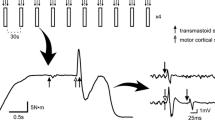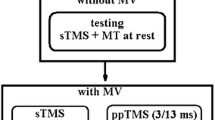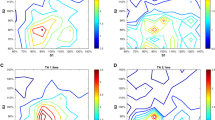Abstract
The short- and long-latency (SLSR, LLSR) components of the stretch reflex response were investigated in the forearm using a paired transcranial magnetic stimulation (TMS)-stretch reflex protocol. Responses to TMS were recorded in the flexor and extensor carpi radialis muscles (FCR, ECR) after conditioning with a rapid wrist extension movement. The cortical stimuli were timed to elicit a motor-evoked potential (MEP) at either the SLSR or LLSR onset in the FCR muscle. Responses were also collected in TMS-alone and stretch reflex-alone conditions. Six intensities of magnetic stimulation were applied in all conditions. In the FCR muscle, MEP amplitude when timed to arrive at the LLSR onset was significantly greater than the sum of the MEP and stretch reflex responses when given separately. MEP amplitudes at the SLSR onset in the FCR muscle and in the ECR muscle at both SLSR and LLSR onset were not significantly different from that expected from the sum of the two stimuli given separately. This indicates heightened corticospinal excitability at a time corresponding to the passage of an afferent volley induced by the stretch, and raises the possibility of a transcortical loop of the LLSR in the forearm. The extent of MEP facilitation was generally consistent across all stimulus intensities tested. A reduced component of the LLSR was evident when the stretch response was timed to arrive during the silent period following the cortical stimulus, suggesting both cortical and sub-cortical components to the reflex response.





Similar content being viewed by others
References
Bertasi V, Bertolasi L, Frasson E, Priori A (2000) The excitability of human cortical inhibitory circuits responsible for the muscle silent period after transcranial brain stimulation. Exp Brain Res 132:384–389
Capaday C, Forget R, Fraser R, Lamarre Y (1991) Evidence for a contribution of the motor cortex to the long-latency stretch reflex of the human thumb. J Physiol 440:243–255
Chen R, Lozano AM, Ashby P (1999) Mechanism of the silent period following transcranial magnetic stimulation. Exp Brain Res 128:539–542
Cody FWJ, Goodwin CN, Richardson HC (1987) Effects of ischaemia upon reflex electromyographic responses evoked by stretch and vibration in human wrist flexor muscles. J Physiol 391:589–609
Cohen LG, Meer J, Takka I, Biemer S, Leidermann DB, Dubinsky RM, Sanes JM, Jabbari B, Bransum B, Hallet M (1991) Congenital mirror movements: abnormal organisation of motor pathways in two patients. Brain 114:381–403
Day BL, Dressler D, Maertens de Noordhout A, Marsden CD, Nakashima K, Rothwell JC, Thompson PD (1989) Electric and magnetic stimulation of human motor cortex: surface EMG and single motor unit responses. J Physiol 412:449–473
Day BL, Riescher H, Struppler A, Rothwell JC, Marsden CD (1991) Changes in the response to magnetic and electrical stimulation of the motor cortex following muscle stretch in man. J Physiol 433:41–57
Deuschl G, Ludolph A, Schenck E, Lucking CH (1989) The relations between long-latency reflexes in hand muscles, somatosensory evoked potentials and transcranial stimulation of motor tracts. Electroencephalogr Clin Neurophysiol 74:425–430
Deuschl G, Michels R, Berardelli A, Schenck E, Inghilleri M, Lucking CH (1991) Effects of electric and magnetic transcranial stimulation on long latency reflexes. Exp Brain Res 83:403–410
Fellows SJ, Topper R, Schwarz M, Thilmann AF, Noth J (1996) Stretch reflexes of the proximal arm in a patient with mirror movements: absence of bilateral long-latency components. Electroencephalogr Clin Neurophysiol 101:79–83
Fuhr P, Agostino R, Hallett M (1991) Spinal motor neuron excitability during the silent period after cortical stimulation. Electroencephalogr Clin Neurophysiol 81:257–262
Goodin DS, Aminoff MJ, Shih PY (1990) Evidence that the long-latency stretch responses of the human wrist extensor muscle involve a transcerebral pathway. Brain 113:1075–1091
Hammond PH (1955) Involuntary activity in biceps following the sudden application of velocity to the abducted forearm. J Physiol 127:23P–25P
Haug BA, Schonle PW, Knobloch C, Kohne M (1992) Silent period measurement revives as a valuable diagnostic tool with transcranial magnetic stimulation. Electroencephalogr Clin Neurophysiol 85:158–160
Hayashi R, Becker WJ, White DG, Lee RG (1987) Effects of ischemic nerve block on the early and late components of the stretch reflex in the human forearm. Brain Res 403:341–344
Ho K-H, Nithi K, Mills KR (1998) Covariation between human intrinsic hand muscles of the silent periods and compound muscle action potentials evoked by magnetic brain stimulation: evidence for common inhibitory connections. Exp Brain Res 122:433–440
Inghilleri M, Berardelli A, Cruccu G, Manfredi M (1993) Silent period evoked by transcranial stimulation of the human cortex and cervicomedullary junction. J Physiol 466:521–534
Jaeger RJ, Gottlieb GL, Agarwal GC (1982) Myoelectric responses at flexors and extensors of human wrist to step torque perturbations. J Neurophysiol 48:388–402
Lee RG, Tatton WG (1975) Motor responses to sudden limb displacements in primates with specific CNS lesions and in human patients with motor system disorders. Can J Neurol Sci 2:285–293
Marsden CD, Merton PA, Morton HB (1973) Is the human stretch reflex cortical rather than spinal? Lancet i:759–761
Marsden CD, Merton PA, Morton HB, Adam J (1977) The effect of lesions in of the sensory motor cortex and capsular pathways on servo-responses from the human long thumb flexor. Brain 100:503–526
Marsden CD, Rothwell JC, Day BJ (1983) Long-latency automatic responses to muscle stretch in man: origin and function. Adv Neurol 39:509–539
Matthews PBC (1984) Evidence from the use of vibration that the human long-latency stretch reflex depends upon spindle secondary afferents. J Physiol 348:373–415
Matthews PBC (1987) The effect of cooling the arm on the long-latency response of the human abductor digiti minimi. J Physiol 382:75P
Matthews PBC, Farmer SF, Ingram DA (1990) On the localization of the stretch reflex of intrinsic hand muscles in a patient with mirror movements. J Physiol 428:561–577
Miscio G, Pisano F, Del Conte C, Pianca D, Colombo R, Schieppati M (2001) The shortening reaction of forearm muscles: the influence of central set. Clin Neurophysiol 112:884–894
Palmer E, Ashby P (1992) Evidence that a long latency stretch reflex in humans is transcortical. J Physiol 449:429–440
Roick H, von Giesen HJ, Benecke R (1993) On the origin of the postexcitatory inhibition seen after transcranial magnetic brain stimulation in awake human subjects. Exp Brain Res 94:489–498
Rothwell JC (1990) Long latency reflexes of human arm muscles in health and disease. Electroencephalogr Clin Neurophysiol S41:251–263
Schnitzler A, Benecke R (1994) The silent period after transcranial magnetic stimulation is of exclusive cortical origin: evidence from isolated cortical ischemic lesions in man. Neurosci Lett 180:41–45
Shimizu T, Oliveri M, Filippi MM, Palmieri MG, Pasqualetti P, Rossini PM (1999) Effect of paired transcranial magnetic stimulation on the cortical silent period. Brain Res 834:74–82
Siedenberg R, Goodin DS, Aminoff MJ (1999) Changes of forearm EMG and cerebral evoked potentials following sudden muscle stretch in patients with Huntington’s disease. Muscle Nerve 22:1557–1563
Taylor JL, Allen GM, Butler JE, Gandevia SC (1997) Effect of contraction strength on responses in biceps brachii and adductor pollicis to transcranial magnetic stimulation. Exp Brain Res 117:472–478
Tergau F, Wanschura V, Canelo M, Wischer S, Wassermann EM, Ziemann U, Paulus W (1999) Complete suppression of voluntary motor drive during the silent period after transcranial magnetic stimulation. Exp Brain Res 124:447–454
Thilmann AF, Schwarz M, Topper R, Fellows SJ, Noth J (1991) Different mechanisms underlie the long-latency stretch reflex response of active human muscle at different joints. J Physiol 444:631–643
Wallace JC, Miles TS (2001) Cortical excitability is not depressed in movement-modulated stretch response of human thumb flexor. Exp Brain Res 139:448–453
Wilson SA, Lockwood RJ, Thickbroom GW, Mastaglia FL (1993) The muscle silent period following transcranial magnetic cortical stimulation. J Neurol Sci 114:216–222
Wu T, Sommer M, Tergau F, Paulus W (2000) Modification of the silent period by double transcranial magnetic stimulation. Clin Neurophysiol 111:1868–1872
Ziemann U, Netz J, Szelenyi A, Homberg V (1993) Spinal and supraspinal mechanisms contribute to the silent period in the contracting soleus muscle after transcranial magnetic stimulation of human motor cortex. Neurosci Lett 156:167–171
Acknowledgements
Funding for this study was provided by the Neurological Foundation of New Zealand. GL is supported by a fellowship from the Brinson Foundation (Chicago, IL, USA). The authors would like to thank Cathy Stinear for her assistance with data analysis, and Eric Perreault and Colum MacKinnon for their helpful comments on the manuscript.
Author information
Authors and Affiliations
Corresponding author
Rights and permissions
About this article
Cite this article
Lewis, G.N., Polych, M.A. & Byblow, W.D. Proposed cortical and sub-cortical contributions to the long-latency stretch reflex in the forearm. Exp Brain Res 156, 72–79 (2004). https://doi.org/10.1007/s00221-003-1767-z
Received:
Accepted:
Published:
Issue Date:
DOI: https://doi.org/10.1007/s00221-003-1767-z




